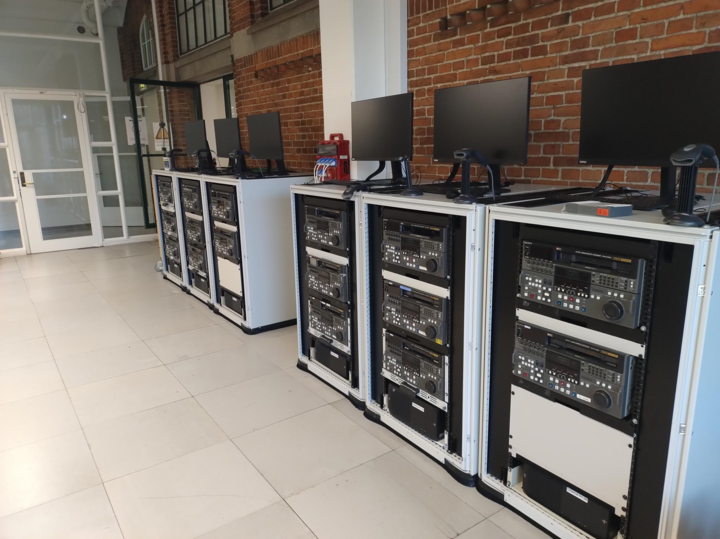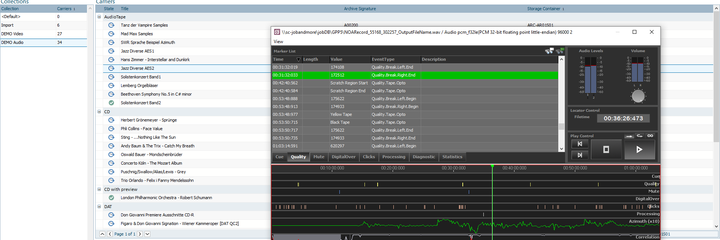The importance of systematic digitization
As I laid out in my previous blog post on handling complex integration projects, there are two approaches to managing the digitization of audiovisual archives: the first one is production based, following individual short-term requests for daily productions, while the second approach, the one of systematic digitization, is guided by a broader view on the entire archived material. The latter method allows users to overcome degralescence (quoting Mike Casey in his article Why Media Preservation can’t wait: The Gathering Storm, published in IASA journal no 44 – January 2015, degralescence is the result of the degradation of carriers combined with the obsolescence of replayers) and may also create detailed metadata for future searches. It’s also a long-term investment that permits quality to play a key role in the different levels of digitization.
To illustrate the idea, let’s take a look at a typical production-driven scenario. Take, for example, Mrs. Archibaldo. She has a lot of content and footage of the Monaco 1976 Grand Prix. Due to the current Covid-19 crisis, Formula 1 will not take place this year. So, the sport department of her company would like to create a compilation showing the best of last century’s Formula 1. So far, so good (and common) – but the sad truth is, that Mrs. Archibaldo knows that with the typical production-based approach, it’ll take a few weeks or even months to get the material queued in their production ingest server.
On the other hand, let’s take a look at Mrs. Hämäläinen – her broadcast company has created a better strategy when working with archives. Systematic digitization has made the process much smoother and her team is ready for any such request. Yle, the Finish national broadcaster, for example uses this method and is able to quickly request a specific, archived AV asset by simply searching for the appropriate items in its database. A previously executed systematic digitization lets users instantly preview content and select the high-resolution copy for delivery to their editing stations. All the SD archives from 1970 to 1985 are available and can be delivered in just minutes!
Now what about that bag?
Production-driven digitization versus systematic digitization is often wrongly understood as “archiving” - but in fact, that’s not the case. Production-driven digitization of archive tapes more often than not lands in some temporary ISIS/AVID storage (for TV) or temporary production storage for radio for editing and later playout. And only if one is lucky, it will somehow be saved onto some HSM archive tier appendix.Where is my bag?And what about useful metadata? Forget it. With this approach, it’ll basically just be dumped off, perhaps including some notes of the editor, which are often only relevant in the context of their current editing task. Similar to the above mentioned piece of luggage, which has been deposited at a train station’s lost and found without any more description than “handbag”. If the owner is lucky, the clerk has recorded additional information for them to be able to claim it; like: handbag, light leather, brown handles, wheels, a scratch on the right bottom corner. But the reality is that without a detailed description, the item will not be found in the vast storing place and will be destroyed or auctioned off after a few months to make space for other lost property.
That´s basically how the archiving process takes place in most production environments — even at national broadcasters, western europe is here luckily the exception. That means there is no room for long-term archiving and often no dedicated strategy for systematic legacy archiving.
On the other hand though, systematic digitization inherently and purposefully includes the collection of all available and relevant metadata around a historical item. Side sleeves, box pictures, editors’ notes on some paper within the box, possibly an existing database export — all this can be used to later refine the search process.
Creativity and cost reduction
And finally, the systematic approach to archive digitization allows you, dear archivist, to create valuable content for a fraction of the production cost just by digitizing already available material. It lets you devise historical channels, save money (when done inhouse compared to outsourced), encourage creativity among producers. It has also proven, as was the case during the Covid-19 lockdown, that it delivers high-quality content, even when no production teams can work in the field.Fortunately, systematic in-house digitization is really a simple and cost-effective task for 95% of your archive’s content. All you need to do is prepare the appropriate workbench that allows you to treat 95% of your unproblematic formats in a correct manner with the highest quality control available.
This long-term strategy will benefit your institution and it’ll also help you play an important role in contributing to the world’s important mission of preserving invaluable patrimony that is destined for education, research, and entertainment for decades to come.



